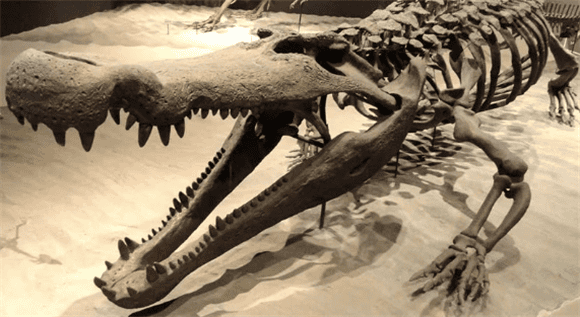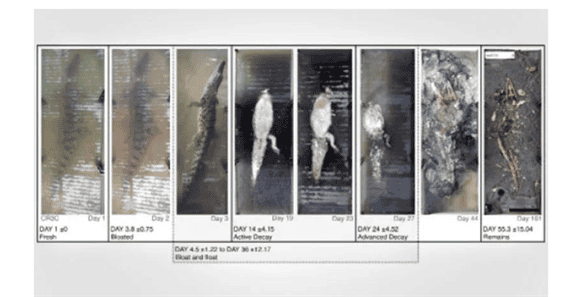Australian researchers recently conducted a study on the decomposition of crocodile carcasses in water, which has important implications for the formation of fossils.

1
The purpose of the research is to better Understand the functions and processes that bones undergo after meat decays, because this will affect the remaining bones and their connection status.
For example, if the upper end of the long leg bone or femur is far away from the hip joint, then that part of the skeleton is out of joint.
If the bones of a fossil skeleton are scattered, the skeleton is completely disjointed.
Crocodiles were chosen for the experiment because crocodile fossils are common around the world and their skeletons usually remain intact and well-joined.
▶ Crocodile fossils
In the experiment, eight dead Australian saltwater crocodiles (Crocodylus porosis) were placed in a tank filled with clean water.
They are the largest living reptiles and are huge; but this study used juvenile crocodiles.
Experimental subjects were divided into three groups to evaluate the impact of burial speed and time on the decomposition process.
Two bodies were immediately buried under 20 centimeters of fine sand, simulating rapid burial.
Three corpses were left in the water so that they could "swell and float" and were buried after they sank to the bottom of the water a few weeks later. At this time they were buried under 20 centimeters of fine sand, simulating delayed burial.
The other three bodies were never buried.
▶ Shown is a crocodile carcass from Group 3 at different stages after it "swelled and floated". The crocodiles in Group 3 were not buried and were left to rot in still water.
Some interesting findings
The crocodiles in Groups 2 and 3 both swelled and floated within 3-5 days, with an average of 32 days floating. This illustrates how quickly animals must be buried after death to preserve them better.
At the end of the experiment, the crocodiles in Groups 2 and 3 "...most of the axial bones, forelimbs, and hindlimbs were partially connected or disconnected."
One crocodile in Group 1 did not Covered by 20 centimeters of fine sand, on the 12th day, the crocodile "swelled and floated" and emerged from the sand layer (it was reburied the next day). These immediately buried crocodiles differed from other crocodiles in that they remained in place with their joints connected. 3
The authors summarize these findings by saying: "... situations where joints are preserved... are more likely to be the result of rapid burial" 4 . "...as the body rots in still water," the joints are less likely to hold together. In addition, "...if we inhibit the body from floating up, the likelihood of the joints being preserved increases."
2
Considering that Group 1 was buried in the sand One of the crocodiles in the carcass "swelled and floated" out of the sand. The author further concluded: "Therefore, before the body begins to swell (within about 4 days), the burial speed must not only be fast, but also need enough sediment to offset it." The positive buoyancy generated by the gas in the body. ” (emphasis added) 5
Therefore, for the entire fossil skeleton to be well preserved, it first needs to be buried quickly and protected in time to prevent it from being eaten by scavengers. The covering sediment must also be deep enough to prevent scavengers from digging through it, and heavy enough so that the carcass does not float due to gases from decomposition.
However, in today's conditions, where would the sediment needed to cover a crocodile come from? It is very rare to produce sediments thicker than 20 centimeters, or very limited in terms of area; and even this depth was obviously not enough in this experiment. Much more sediment would be needed to bury an animal much larger than a juvenile crocodile.
The researchers raised other possibilities for sediments quickly burying animals. They thought the body might be stuck in the log! The body may have swelled on dry ground and somehow ended up in the water. Or, extremely cold or deep water may reduce the degree of expansion. As for how to prevent the intrusion of scavengers that live here and prevent the skeleton from becoming detached, they cannot explain. Regardless, experiments have shown that unburied fish carcasses can become severely detached within a week, even in the absence of oxygen and scavenger intrusion. 6 None of these explanations explain the large deposits of fossils of crocodiles and other animals around the world, one of which is in South Africa's Karoo basin (about 500,000 square kilometers).

▶ Giant crocodiles living in the water
Scientists who have been monitoring the movement of sediments around the world for more than seventy years have long recognized that there are not enough sediments to meet the conditions for widespread fossilization. Sediments are deposited in rivers, lakes, estuaries, lagoons and oceans around the world, and are also formed in smaller storms and rare disasters. However, none of these environments produced sedimentary layers large enough to bury large numbers of animals over large areas.
But there is one disaster that can produce enough sediment. "The waters were so great on the earth that all the mountains under the heaven were covered. - Genesis 7:19" The flood described in Genesis will erode the land and create a large amount of sediment, forming hundreds of thousands of sediments in many parts of the world. Meters of sediment buried all living things in it.
A large number of organisms, though not all, were quickly buried and completely covered, which is what is necessary for the complete preservation of the fossils the researchers found. So we could predict that, in addition to a few fragmented fossil skeletons, there would also be a lot of well-connected skeletons—and that's exactly what we found.
More considerations
If the sediment coverage is slow and gradual, some of the characteristics of the fossil's soft tissues such as skin, muscles, feathers, hair, etc. cannot be preserved, and according to Due to the nature of the environment and sedimentary layers, one would expect that fossils of animals that were quickly buried would often retain these characteristics. This is also what we found. Moreover, the fossils were buried for only a few thousand years, which could explain the recent discovery of unfossilized soft tissue. Soft tissues like blood cells, hemoglobin, and other proteins are still present in some fossils—including those of dinosaurs that are thought to have gone extinct 65 million years ago.

 扫一扫微信交流
扫一扫微信交流
发布评论